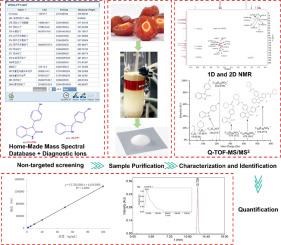Separation, identification, and quantification of dicyclohexylformyl oxyphenisatin, an illegal additive, from a fruit and vegetable plum
IF 3.2
引用次数: 0
Abstract
Purpose
This study is to develop an effective method for separating, identifying, and quantifying suspected illegal additives from fruit and vegetable plums.
Methods
Ultra performance liquid chromatography coupled with quadrupole-time-of-flight mass spectrometry (UPLC-Q-TOF/MS) was employed to perform non-targeted screening of illegal additives from more than 10 batches of fruit and vegetable plums. A diesterified oxyphenisatin analog never detected before in foodstuffs was identified from a batch of fruit and vegetable plum. This analog was separated and purified by column chromatography, and its molecular structure was analyzed and identified using one dimension and two dimension-nuclear magnetic resonance spectra (1D and 2D NMR). After obtaining the synthesized reference standard, an UPLC-PDA detection method for the quantitative analysis of this analog in real samples was established.
Results
The results showed that the characteristic fragment ions with mass/charge ratio (m/z) of 224.07 and 196.07 appeared in the MS2 spectrum, indicating that the analog had the skeleton of oxyphenisatin. Combining the fitted molecular formula of suspected compound, its degree of unsaturation, and the fragment ions with mass/charge ratios of 428.18, 334.14, 83.08 in the secondary mass spectrum, we speculated that the anhydride of esterified oxyphenisatin might be cyclohexanecarboxylic anhydride, which was in good consistent with NMR spectroscopic analysis. Based on these findings, the analog was eventually named dicyclohexylformyl oxyphenisatin. UPLC-PDA test results showed that the content of this analog in a batch of fruit and vegetable plum was 614.0 mg/kg.
Conclusion
As far as we know, dicyclohexylformyl oxyphenisatin is not a food additive. Structurally, it is the product from dicyclohexylformylation of oxyphenisatin. The illegal addition of this analog to food will cause unknown harm to uninformed consumers and requires the attention of relevant departments.

果蔬李子中非法添加剂二环己基甲酰基氧苯醌的分离、鉴定和定量
目的建立一种有效的分离、鉴定和定量果蔬李子中可疑非法添加剂的方法。方法采用高效液相色谱-四极杆飞行时间质谱联用技术(UPLC-Q-TOF/MS)对10多批果蔬李子进行非靶向筛选。从一批水果和蔬菜李子中鉴定出了以前从未在食品中检测到的二酯化氧苯醌类似物。采用柱层析分离纯化该类似物,并利用一维和二维核磁共振波谱(1D和2D NMR)对其分子结构进行分析和鉴定。在得到合成的参比标准品后,建立了UPLC-PDA检测方法,用于实际样品中该类似物的定量分析。结果MS2光谱中出现质量电荷比(m/z)分别为224.07和196.07的特征片段离子,表明该类似物具有氧苯那辛的骨架。结合拟合的疑似化合物分子式、不饱和程度以及二级质谱中质荷比分别为428.18、334.14、83.08的碎片离子,推测酯化后的氧苯那汀酸酐可能为环己烷羧酸酐,与核磁共振分析结果吻合较好。基于这些发现,这种类似物最终被命名为双环己基甲酰基oxyphenisatin。UPLC-PDA试验结果表明,该类似物在一批果蔬李中的含量为614.0 mg/kg。结论就目前所知,双环己基甲酰基氧苯醌不属于食品添加剂。从结构上看,它是氧苯醌的双环己基甲酰化产物。在食品中非法添加这种类似物会对不知情的消费者造成未知的危害,需要引起有关部门的重视。
本文章由计算机程序翻译,如有差异,请以英文原文为准。
求助全文
约1分钟内获得全文
求助全文
来源期刊

Journal of chromatography open
Analytical Chemistry
CiteScore
2.50
自引率
0.00%
发文量
0
审稿时长
50 days
 求助内容:
求助内容: 应助结果提醒方式:
应助结果提醒方式:


